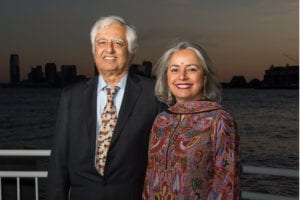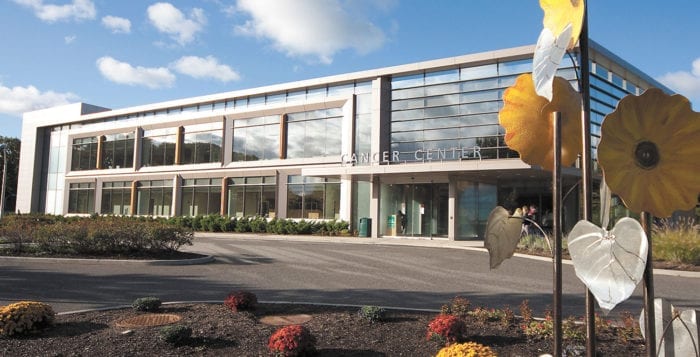Generosity, particularly towards Stony Brook University, runs in the family at Renaissance Technologies.
Lalit Bahl, a veteran of the hedge fund, and his wife Kavita, who are Setauket residents, recently agreed to donate $10 million to a new translational research program that will complement Stony Brook’s effort to understand and conquer cancer. The financial gift, which will support a metabolomics and imaging center that will provide individualized cancer care, comes two years after the Bahls donated $3.5 million to a similar effort.
Bahl said he was following a long-established tradition.
“Many of my colleagues at Renaissance have donated significant amounts to Stony Brook and in particular the medical side over the years,” Bahl said. “I’ve heard from some of them about some of the projects that they have been involved in. I’m sure that played some part in my decision to make this donation.”
Another compelling factor in that decision, Bahl said, was the prevalence of cancer in his family.
Jim Simons, former chairman of the Mathematics Department at Stony Brook, founded Renaissance Technologies, bringing in a range of expertise to understand and predict movements in the stock market. Simons and his wife Marilyn have made significant contributions to Stony Brook that have helped bring in talented staff.
Indeed, in 2012 the school recruited distinguished scientists Yusuf Hannun, the director of the Cancer Center and Lina Obeid, the dean for research and professor of medicine. Hannun and Obeid, with the support of other senior faculty in the Cancer Center, will help oversee the creation of an advanced metabolomics and imaging center in the new Medical and Research Translation building when it opens in 2018.

“We have high-powered, brilliant investigations in cancer medicine,” Hannun said. “This creates the capability that will allow them to take their work to the next level, in developing new therapeutics as well as in imaging studies.”
The new facilities include a cyclotron, which is used to create novel tracer molecules for PET scanning, hot labs that produce radioactive tracers for the cyclotron, two PET scanners and research labs.
Imaging will enable doctors to monitor patients, in some cases without excising a tissue sample or performing surgery.
The imaging will “distinguish between a tumor [that] is necrotic and dying [and one] that’s metabolically active,” said Obeid. That will help track and monitor the patient’s response to various medicines and chemotherapy in a noninvasive way.
Metabolomics is the study of the small molecules or metabolites that help cells function. Some of those metabolites provide energy while others could act as signaling molecules, and still others could be involved in other structural or functional effects.
In addition to new equipment, Stony Brook will add new scientists to its fight against cancer. During the first phase, the school will recruit an oncological imaging researcher, a matrix-assisted laser desorption ionization researcher and a magnetic resonance spectroscopy researcher. In the second phase, Stony Brook will hire a new scientist in experimental therapeutics.
Ken Kaushansky, the dean of the School of Medicine, appreciates the progress the school is making in cancer research and is energized by the combination of philanthropic gifts and investments from the university.
“There’s something remarkably catalytic about a brand new building,” Kaushansky said. He said he’s had regular discussions with people who want an opportunity to work in the new facility.
While the broader goal is, and continues to be, to make important discoveries that will help in the prevention, diagnosis and treatment of cancer, Kaushansky reiterated the school’s desire to earn a National Cancer Institute designation. This designation, which has been given to 69 institutions throughout the United States, raises its visibility and increases the opportunities to become part of research initiatives, while it also improves the chances that an individual scientist will obtain research funding from the National Cancer Institute, according to that organization’s web site.
“We have far surpassed the threshold of cancer research needed to acquire an NCI designation,” Kaushanksy said, which he attributes to Hannun’s efforts. Stony Brook is “now focusing on building up our clinical research prowess. That’s the second major component. I like our chances.”
The next area Stony Brook hopes to build is cardiovascular imaging, Kaushansky said.
“We have some remarkable cardiovascular surgeons and some terrific cardiovascular biologists,” Kaushansky said. “We need some outstanding cardiovascular imagers to work with [them]. We can use the incredible tools that we are building to do to cardiovascular medicine what we are doing to cancer.”





